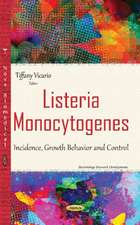Anaerobic Bacteria: Developments Series
Autor K. T. Hollanden Limba Engleză Paperback – 11 noi 2011
Preț: 383.33 lei
Nou
Puncte Express: 575
Preț estimativ în valută:
73.36€ • 75.78$ • 61.05£
73.36€ • 75.78$ • 61.05£
Carte tipărită la comandă
Livrare economică 26 martie-09 aprilie
Preluare comenzi: 021 569.72.76
Specificații
ISBN-13: 9781461289951
ISBN-10: 1461289955
Pagini: 220
Ilustrații: IX, 206 p.
Dimensiuni: 152 x 229 x 12 mm
Greutate: 0.3 kg
Ediția:Softcover reprint of the original 1st ed. 1987
Editura: Springer Us
Colecția Springer
Seria Developments Series
Locul publicării:New York, NY, United States
ISBN-10: 1461289955
Pagini: 220
Ilustrații: IX, 206 p.
Dimensiuni: 152 x 229 x 12 mm
Greutate: 0.3 kg
Ediția:Softcover reprint of the original 1st ed. 1987
Editura: Springer Us
Colecția Springer
Seria Developments Series
Locul publicării:New York, NY, United States
Public țintă
ResearchCuprins
1 Anaerobes and Oxygen.- 1.1 Oxygen toxicity.- 1.2 The intolerance of anaerobes.- 1.3 Oxygen and redox potential.- 1.4 Oxygen and growth media.- 2 Physiology of Anaerobes.- 2.1 Energy transduction: general considerations.- 2.2 Photosynthetic mechanisms.- 2.3 Non-photosynthetic ATP production.- 2.4 Electron transport linked phosphorylation: anaerobic respiration.- 2.5 Substrate-level phosphorylation: fermentation.- 2.6 Carbon dioxide fixation.- 2.7 Other aspects of metabolism.- 2.8 Transport of substrates by anaerobes.- 2.9 Antimicrobial agents.- 3 Techniques in Anaerobic Microbiology.- 3.1 Oxygen exclusion technique.- 3.2 Anaerobic incubation systems.- 3.3 Growth techniques for microaerophiles.- 3.4 Specialized media.- 3.5 Methods for isolation and selection of particular anaerobes.- 3.6 Miscellaneous techniques.- 3.7 Continuous culture.- 4 Types of Anaerobic and Microaerophilic Bacteria.- 4.1 Origins.- 4.2 Phototrophic bacteria.- 4.3 Spirochaetes.- 4.4 Anaerobic Gram-negative bacilli.- 4.5 The methanogenic bacteria.- 4.6 Anaerobic cocci.- 4.7 Gram-positive non-sporing bacilli.- 4.8 Endospore-forming anaerobes.- 4.9 Wall-deficient bacteria: L-forms and Anaeroplasma.- 4.10 Microaerophilic bacteria.- 4.11 Anaerobes of the future.- 5 Anaerobes in Natural Environments.- 5.1 The gastro-intestinal tract.- 5.2 The rumen.- 5.3 Human intestinal flora.- 5.4 The intestine of other animals.- 5.5 The bacteria of the mouth.- 5.6 Anaerobic habitats in other parts of the body.- 5.7 Aquatic and marine habitats.- 5.8 Soil.- 5.9 Study of habitats.- 5.10 Detrimental effects of obligate anaerobes.- 6 Anaerobes of Medical Importance.- 6.1 Aetiology, incidence and sites of infection.- 6.2 Clostridia.- 6.3 Campylobacter.- 6.4 Bacteroides.- 6.5 Treponema pallidum.- 7 Industrial Applications ofAnaerobes.- 7.1 Retting.- 7.2 Chemical production by anaerobes.- 7.3 Anaerobic digestion.- 7.4 Vaccines.- 7.5 Biochemicals and enzymes.- 7.6 Future possibilities.- References.















